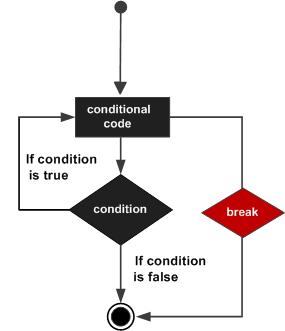Scala break語句
因為這樣的事,在Scala中可以冇有內置break語句,但如果正在運行的Scala2.8,那麼還有一個辦法使用break語句。當break語句在循環中遇到循環立即終止,程序控製繼續下一個循環語句後麵的。
語法:
break語句的語法是有點不同尋常,但它的工作原理:
// import following package import scala.util.control._ // create a Breaks object as follows val loop = new Breaks; // Keep the loop inside breakable as follows loop.breakable{ // Loop will go here for(...){ .... // Break will go here loop.break; } }
流程圖:

示例:
import scala.util.control._ object Test { def main(args: Array[String]) { var a = 0; val numList = List(1,2,3,4,5,6,7,8,9,10); val loop = new Breaks; loop.breakable { for( a <- numList){ println( "Value of a: " + a ); if( a == 4 ){ loop.break; } } } println( "After the loop" ); } }
當上述代碼被編譯和執行時,它產生了以下結果:
C:/>scalac Test.scala C:/>scala Test Value of a: 1 Value of a: 2 Value of a: 3 Value of a: 4 After the loop C:/>
打斷嵌套循環:
使用嵌套循環打破現有循環。所以,如果有使用break嵌套循環,那麼下麵的方式來進行:
示例:
import scala.util.control._ object Test { def main(args: Array[String]) { var a = 0; var b = 0; val numList1 = List(1,2,3,4,5); val numList2 = List(11,12,13); val outer = new Breaks; val inner = new Breaks; outer.breakable { for( a <- numList1){ println( "Value of a: " + a ); inner.breakable { for( b <- numList2){ println( "Value of b: " + b ); if( b == 12 ){ inner.break; } } } // inner breakable } } // outer breakable. } }
當上述代碼被編譯和執行時,它產生了以下結果:
C:/>scalac Test.scala C:/>scala Test Value of a: 1 Value of b: 11 Value of b: 12 Value of a: 2 Value of b: 11 Value of b: 12 Value of a: 3 Value of b: 11 Value of b: 12 Value of a: 4 Value of b: 11 Value of b: 12 Value of a: 5 Value of b: 11 Value of b: 12 C:/>


